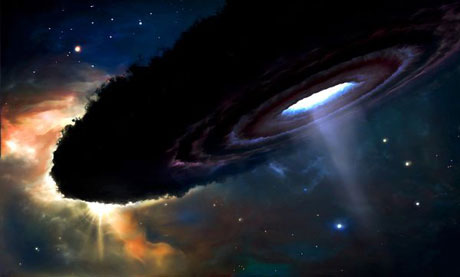Decode the mysterious star three times bigger than the sun
Astronomers said yesterday they have found the secret of a star that has attracted astronomers' attention for nearly 200 years.

Illustration of cloud of air dust covering part of the light of star Epsilon Aurigae.Photo: National Geographic.
AFP said, why Epsilon Aurigae is located in the Auriga constellation and about 2,000 light-years from Earth. In this constellation Epsilon Aurigae is one of the brightest celestial bodies. But around 1820 astronomers discovered that, after 27.1 years of brightness, it halved in 18 months.
The strange phenomenon became a controversial topic during nearly two centuries. Some argue that the culprit is a celestial phenomenon, meaning that a celestial body moves between Epsilon Aurigae and the earth in a 27.1-year cycle that causes people on the earth to see the star's brightness decrease. Celestial objects blocking Epsilon Aurigae can be planets, cloud of gas dust, stars or even nebulae. Another hypothesis is also noted that a black hole has "swallowed" the star's light.
The controversy becomes even more intense after it is discovered that Epsilon Aurigae with another star forms a binary star system. Pairs like that always revolve around each other. Astronomers have never seen both stars at the same time.
For most of the 20th century, scientists accepted the theory that an extremely cold and flattened celestial body blocked the light of Epsilon Aurigae.
The natural phenomenon of the star Epsilon Aurigae, lasting from 2009 to 2011, is one of the central themes of the International Astronomy Year 2009.
National Geographic reported that Robert Stencel - an astronomer from the University of Denver, USA - and some colleagues photographed the Epsilon Aurigae with four large telescopes (1 m in diameter) of the University of Georgia, USA. Then its infrared light is amplified by the interference method to create a high-definition image.
The photos, published in Nature today, show that the culprit of the starlight Epsilon Aurigae is a thick, dark disc of gas. When moving between Epsilon Aurigae and the globe, this dust disc blocks part of the star's light, causing its brightness to decrease.
Clouds of gas dust are the basic material of the universe. They form planets, stars and galaxies.
Professor John Monnier of the University of Michigan in the US, a member of the research team, commented: 'Photos of how Epsilon Aurigae is a great technical achievement. They show that humans can create a clear image of very distant objects. '
A bunch of photos about how Epsilon Aurigae:

Epsilon Aurigae reached its maximum brightness in 2008. The latest data shows that this star is about 3.5 times larger than the sun.Photo: John D. Monnier.

The disk of gas dust begins to obscure Epsilon Aurigae. Scientists think that the cloud is thousands of times more massive than the sun.Photo: John D. Monnier.

About 50% of the star surface is obscured.

Illustration of a disk of gas dust that obscures Epsilon Aurigae.Photo: Nico Camargo.
- The mysterious age of the mysterious star
- The star is nearly 2,000 times bigger than the Sun, lighter than water
- RCW103: The star and the mysterious friend?
- Found another star that mysteriously dimmed
- Mysterious giant star on the surface of the Earth
- The star is about to explode 1,400 times larger than the Sun.
- The scientists were skeptical of discovering Star Death
- Detecting star clusters 30 million times brighter than the Sun.
- The supernova is 20 times brighter than the Milky Way
- The question of alien appearances is 1,500 light years away
- Mysterious binary star systems
- Giant stars are created from 'star nursery'.
 Van Allen's belt and evidence that the Apollo 11 mission to the Moon was myth
Van Allen's belt and evidence that the Apollo 11 mission to the Moon was myth The levels of civilization in the universe (Kardashev scale)
The levels of civilization in the universe (Kardashev scale) Today Mars, the sun and the Earth are aligned
Today Mars, the sun and the Earth are aligned The Amazon owner announced a secret plan to build a space base for thousands of people
The Amazon owner announced a secret plan to build a space base for thousands of people